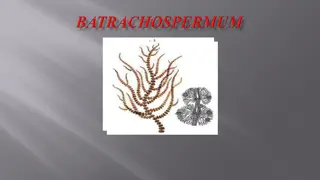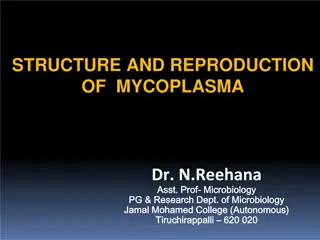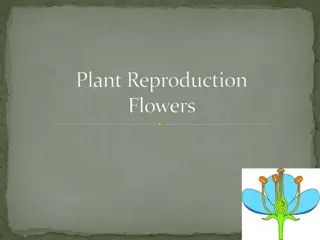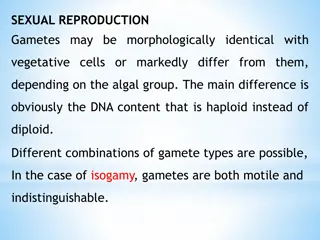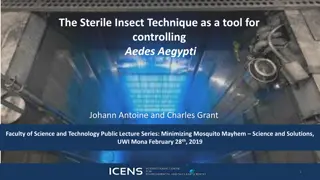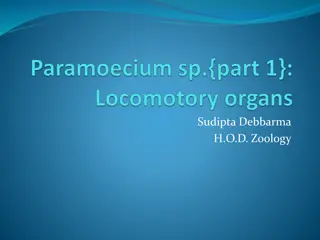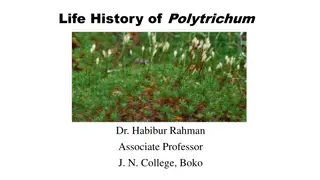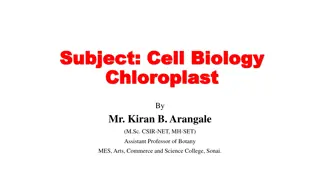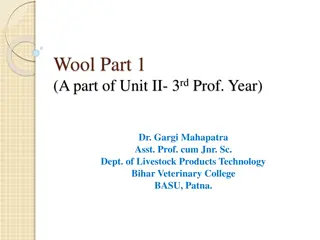Bryophyta Thallus Structure and Reproduction in Hepaticopsida
The Bryophyta group includes structures like thalli and reproductive organs, particularly in the class Hepaticopsida. These plants have simple or foliose body structures with distinct characteristics such as aseptate rhizoids, ventral scales, and chloroplasts without pyrenoids. The gametophyte is strap-shaped, sporophyte shows differentiation into foot, seta, and capsule. Reproduction involves sexual processes, with monoecious features like antheridia and archegonia found on the thalli. Structural organization and systematic positions of different species like Targionia and Lunularia are also discussed.
Download Presentation

Please find below an Image/Link to download the presentation.
The content on the website is provided AS IS for your information and personal use only. It may not be sold, licensed, or shared on other websites without obtaining consent from the author. Download presentation by click this link. If you encounter any issues during the download, it is possible that the publisher has removed the file from their server.
E N D
Presentation Transcript
Bryophyta-Thallus Structure Susan Kuriakose Assistant Professor Department of Botany Mar Thoma College,Tiruvalla
Hepaticopsida-General characters Plant body thalloid or foliose Aseptate rhizoids-simple or tuberculate,ventral scales present Chloroplast without pyrenoids Simple or compound oil bodies Sex organs develop from superficial cells on the dorsal side of the thallus Sporophyte simple or differentiated in to foot ,seta and capsule Sporogenous cells from endothecium Columella absent,elaters may be present Sporophyte completely dependent upon gametophyte
Marchantiales- Targionia Division:Bryophyta Class:Hepaticopsida Order:Marchantiales Family:Targioniaceae Genus:Targionia Species:hypophylla
Structural organisation Gametophyte Simple strap shaped thallus Sparingly dichotomously branched Two rows of ventral scales on either side of the midrib-scales simple or appendaged Rhizoids are simple and tuberculate. The mid dorsal groove (Riccia),polygonal area and gemmae cups(Marchantia) are absent. Photosynthetic/assimilatory region-Single row of airchambers with branched or unbranched filaments. Storage zone-similar to Riccia Sporophyte Foot,sets,capsule Capsule has a lid or operculum at the apex. Some elaters get fixed at the apex.they are short,stumpy with annular or spiral thickening. Free elaters are larger with 2 or 3 spiral thickening. After the removal of lid capsule dehisces in to valves. Capsule wall is one cell thick with annular or semiannular thickening 4-8 irregular
Reproduction Sexual rpdn Veg. rpdn Monoecious(homothallic) Antheridia-on surface of the adventitious shoots forming cushion like areas- sessile male receptacle. Archegonia-initially at the apex from growing point subsequently downwards. In a mature thallus arch. are found enclosed within a boat shaped 2-lobed involucre at the ventral surface near the apex.(diagno. feature) Numerous adventitious produced surface of midrib. These on detachment help in veg rpdn ventral the dorsal shoots from are spherical ventral produced shifted
Cyathodium Systematic position Thin, once or twice dichotomously branched without midrib,densely overlapping and yellowish green
Lunularia Internal characters External features Thallus,dichotomous&terestrial,found in large overlapping.dorsal pores are simple and raised and bounded by3 rings of 6-8 cells each.scales found in one row on each side of somewhat distinct midrib,they &delicate and attached by a semi- lunar base and appendaged. Assimilatory chambers short branched assimilatory filaments. Storage region-thin parenchymatous. region-air one patches and in layer walled are thin
Reproduction Sexual rpdn Veg.rpdn Male shaped &terminal,surrounded with elevated borders of thallus. Female stalked,delicate&&partially transparent with scattered hairs or naked.trminal branches becomes lateral and surrounded by scales in several rows base.mature receptacle composed of 4-cruciate,horizontal,tubular involucres,each containing a single sporogonium,perianth absent.capsule with a long pedicel remains exerted bilabiate opening of the involucre. receptacle-sessile, disc- Gemmae surface. multicellular,stalked,biconvex with thin margins lateral notches overlaping margins. cups on dorsal are Gemmae receptacle- and 2 with on apparently short at the from the
Sexual rpdn Capsule bands.capsule dehisces nearly to the base by narrow valves. Elaters are long, slender, bispiral& thread like Spores are rounded, tetrahedral, smooth& yellowish brown wall-unistratose &without annular
Dumortiera Internal characters External characters Thalluslarge,prostrate,overlapping and terrestrial,growing streams.repeatedly branching may be due to apical innovations.notched apex undulate margins and midrib.Scales are attached to the thallus in a single row one on each side of the midrib. Lacks air chambers and uppermost cells contain chloroplast near branched prominent reduced and
Sexual rpdn Monoecious or dioecious, Male receptacle-disc shaped,depressed in the center,subsessile with bristles on the margins. Female receptacle-stalk is long and 2 furrowed with its top covered with chaffy scales.Disc shaped ,umbonate,convex with a few bristle like hairs and with 6-10 short lobes.A sacctate involucre is found horizontally on the underside and distinct when sporogonium is young and appear sessile.Perianth absent Capsule wall-unistratose with annular bands Elaters appear fixed arising from bottom Capsule dehisces by splitting into 4-8 valves Elaters are long ,sometimes branched and have 2-4 spiral thickenings. Spores are tetrahedral and dark brown
Reboulia External characters Internal characters Thallus dichotomous, lobes are oblong or emarginate or Thalli green margins.Ventral ventral scales are purple.Scales are arranged in two rows one in each side of the midrib.They are obliquely linear appendages.midrib thickand gradually passing into lamina ending in to one cell thick margin. Air several Plagiochasma. Pores are elevated with 3-5 (rarely 8)concentric rings of 6-8 cells each. chambers arranged as in in obovate bilobed and surface with apex. purple and rows lunate with 2 is
Sexual rpdn Monoecious or dioecious Female receptacle-borne terminally. Stalk remains surrounded at the base and the apex by narrow scales with a single rhizoidal Receptacles are hemispherical divided to the middle into 4-9 obtuse lobes.Airchambers with compound arise on the underside of the lobes from margins. These are bivalved .Each involucres encloses a single sporogonium.Perianth not found Male receptacle- sessile,oval to semicircular cushion-like and surrounded scales. Found at the apex of lobe. furrow. by small conical or pores,Involucres
Sporogonium Large foot,short stalk,sub-globose capsule, capsule wall unistratose.Capsule apex.Elaters have 2-3 spiral thickening and are coiled,long and rarely branched.Spores are brown, spherical, reticulate-lamellate with broad wing. dehisces at the
Porella(Madotheca) Division:Bryophyta Class:Hepaticopsida Order:Jungarmaniales Family:Porellaceae Genus:Porella Species:platyphylla Distribution :Mostly in tropics,Porella platyphylla is cosmopolitan. External characters:greenish,leafy long,dorsiventral,branched central axis, branching is monopodial ,both central axis and branches bear leaf-like expansions(dorsal and ventral leaves in 3 rows),incubous arrangement of leaves-anterior edge of each leaf covers the posterior edge of the leaf in front,dorsal leaf is bilobed- upper or dorsal lobe is large and oval in outline(antical lobe),ventral smaller lobe is called postical lobe or lobule,ventral leaves which is decurrent at the base are called amphigastria,leaves lack nerves and even midrib.P.navicularis have Nostoc.Rhizoids are thin walled and arises from the lower surface near the base of the ventral leaves. and fairly large upto15cm ectophytic association with
Internal Structure of the stem and leaf Young stem consists of green parenchyma cells,even epidermal layer is not well defined,in differentiation,consists of an outer cortical and an inner medullary region Leaf-thin plate of uniform cells ,one cell layer in thickness,cells contain abundant chloroplast, no midrib. the older portion there is
Reproduction Vegetative reproduction: Through fragmentation and regeneration Sexual reproduction--- Porella is dioecious, Male gametophytes are comparatively smaller than the female gametophyte. Antheridia are borne on specialised lateral antheridial branches which project out at right angles to the main axis. The dorsal leaves, called bracts, are smaller than those on the main branch and are closely imbricated. The ventral leaves (amphigastria) of the antheridial branch are known as bracteoles. A single antheridium is borne in the axil of each leaf. The mature antheridium is differentiated into a globose body and a long stalk
Archegonia are produced at the apex of archegonial branch on the female plant. The archegonial branch is much smaller than the vegetative branch, bearing a number of large perichaetial leaves (bracts). The lower bracts form involucre, while the two upper bracts coalesce to form a perianth. Ten to fifteen archegonia develop within the perianth. The archegonia develop in acropetal succession. A mature archegonium differentiates into a neck and a venter. The neck is long, comprises of five vertical rows of neck cells enclosing 6-8 neck canal cells. The venter is 2-layered, consists of a small ventral canal cell and a large egg. A rosette of 4 cover cells is present at the top of the archegonial neck. The process of fertilisation is found to be similar with that of other bryophytes.






